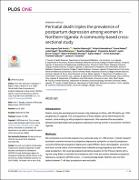| dc.identifier.citation | Arach AAO, Nakasujja N, Nankabirwa V, Ndeezi G, Kiguli J, Mukunya D, et al. (2020) Perinatal death triples the prevalence of postpartum depression among women in Northern Uganda: A community-based cross-sectional study. PLoS ONE 15(10): e0240409. https://doi. org/10.1371/journal.pone.0240409 | en_US |
| dc.description.abstract | Introduction
Deaths during the perinatal period remain a big challenge in Africa, with 38 deaths per 1000
pregnancies in Uganda. The consequences of these deaths can be detrimental to the
women; some ending up with postpartum depression. We examined the association
between perinatal death and postpartum depression among women in Lira district, Northern
Uganda.
Methods
We conducted a community-based cross-sectional study of 1,789 women. Trained research
assistants screened women for postpartum depressive symptoms on day 50 postpartum
using the Edinburgh postpartum depression scale (EPDS). Socio-demographic, economic,
birth and survival status of the neonate were collected during pregnancy and within one
week postpartum. We used generalized estimating equation for the Poisson family with a
log link using Stata to estimate the prevalence ratio of the association between postpartum
depressive symptoms (EPDS scores �14) and perinatal death. Mothers who lost their
babies between 7–49 days postpartum were excluded. Results
Of the 1,789 participants symptomatically screened for postpartum depression, 377
(21.1%) [95% confidence interval (95%CI): 17.2%, 23.0%] had probable depressive symptoms.
The prevalence of postpartum depressive symptoms among the 77 women who had
experienced perinatal death (37 stillbirths and 40 early neonatal deaths (�7 days of life))
was 62.3% [95% CI: 50.8%, 72.6%] compared to 19.2% [95% CI: 17.4%, 21.2%], among
1,712 with live infants at day 50 postpartum. Women who had experienced a perinatal death
were three times as likely to have postpartum depressive symptoms as those who had a live
birth [adjusted prevalence ratio 3.45 (95% CI: 2.67, 4.48)].
Conclusions
The prevalence of postpartum depressive symptoms, assessed by EPDS, was high among
women who had had a perinatal death in Northern Uganda. Women experiencing a perinatal
death need to be screened for postpartum depressive symptoms in order to intervene and
reduce associated morbidity. | en_US |

